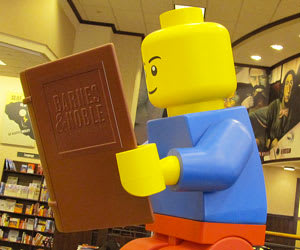
(SA_Steve)
As we’ve discussed in the past, Barnes & Noble does not match its online prices in its brick-and-mortar store. That’s their right in a free economy, but we’ve wondered for a while now whether this could be hurting the chain in the long run. Shopping at Barnes & Noble also differs from the in-store pickup experience at other national chains because even if you place an order online, the price you’re charged when you go to pick the item up might be the higher in-store price.
Travis wrote to us about his recent shopping experience:
I was recently looking for a Lego calendar for my son. I found one. It was the same price at Barnes and Noble (with in store pickup) as it was at Amazon (with amazon prime). Since I had a 15% off any item coupon for Barnes and Noble, I decided to drive there and pick up the calendar. Why not enjoy a nice ride, right? Wrong!
Upon arrival, I see that said calendar is about 14% more expensive in store than online. But, I can order it online and pick up in store, what gives right? Well, after talking to a manager, it turns out, there is an online price, and an in store price. The order online and ship it to your house price is a little cheaper, but you pay for shipping. Oddly, the order online and pick up in store price is more expensive. While the difference here is only about $2, it isn’t the amount of money, it is the general principle. I was pretty annoyed I drove all the way out there to be charged a higher price. If I stayed at home, ordered off amazon prime, I would have gotten it for the same price, just not used a coupon.
What was even more amazing, is the manager of the the store I went to let me leave, angry, over ~$2. Coming from a store who has been showing signs of circling the drain for years now, I can’t understand why they would be so rigid like that. Especially when most other stores match competitors prices, their own website prices, and so on. Amazing.
Travis just turned around and bought the same item using his Amazon Prime membership, resulting in a happy ending for everyone except Barnes & Noble. We hear from many customers who find this policy irritating: why do they continue? Can they afford to keep losing business over $2 here and there, or do so few customers walk out that it doesn’t really make a difference to the company?
Well, we asked them. Here’s their media relations department’s defense of the self-price-matching policy as it stands.
Regarding why pricing on bn.com and in our retail stores is different, there are a number of reasons including:
Barnes & Noble.com is a subsidiary of Barnes & Noble, Inc., with its own management, operations and price structure. The online and retail businesses each offer their own unique selection and competitive price structure. Neither business advertises the other’s price structure. Neither business matches the other’s advertised prices. And, as stated on BN.com:
Barnes & Noble.com usually is able to fill your order with less expense than our retail stores, and we pass those savings on to our online customers. This is why our prices online sometimes are lower than prices in your local Barnes & Noble store. Similarly, at times, your local store may offer exclusive promotions that are not offered at Barnes & Noble.com.
In other words, while we consumers want to think of a company’s website and its storefronts as a unified business entity and a unified shopping experience, it isn’t that simple. It’s kind of like expecting corporate-owned and franchise locations of the same fast-food place to accept the same coupons. They’re united under a single brand in our minds, but not when it comes to prices and promotions.
Editor's Note: This article originally appeared on Consumerist.
















